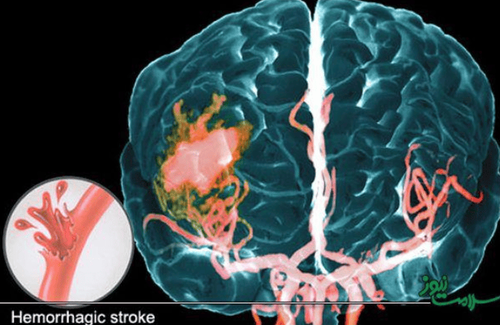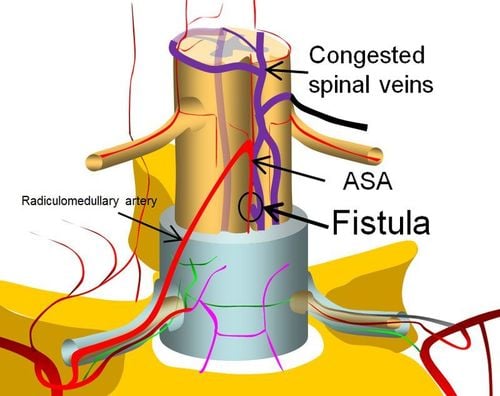This is an automatically translated article.
Cerebrovascular accident is commonly known as caused by high blood pressure, atherosclerosis, blood clots from the heart moving up or brain vascular malformations. However, there is another cause that is less well known – amyloid angiopathy.
1. Causes of powdery vascular disease
Amyloid angiopathy occurs due to the presence of a structurally malformed group of proteins called amyloid. Amyloid's structure is very special with 18 unusual coils compared to other protein groups, in addition it belongs to the group of fibrous and insoluble proteins. Therefore, Amyloid cannot combine well with other normal proteins, leading to the risk of disease when they enter the vessel wall or any other organ in the body.
According to some studies, depending on the structural abnormalities, different types of Amyloid proteins are produced, leading to the risk of infection in different organs in the body. Some typical Amyloid proteins such as Beta-amyloid protein cause dementia (also known as Alzheimer's); Alpha-synuclein causes Parkinson's disease; Serum amyloid A causes arthritis; Lipoprotein Al causes scleroderma; IAPP (Amylin) causes type 2 diabetes...
2. Who is at risk of powdery vascular disease?

Bệnh mạch máu dạng bột thường xảy ra ở những người có độ tuổi từ 55 trở lên, kèm theo triệu chứng sa sút trí tuệ
At present, the risk of amyloid angiopathy has not been confirmed, however, according to statistics, the results show that amyloidosis usually occurs in people aged 55 years and older, accompanied by symptoms of dementia (both caused by the protein Amyloid). Some studies have also shown that amyloidosis is highly likely to be related to some morphology of the Apolipoprotein E gene.
In addition, the risk of amyloidosis is thought to be significantly increased for cases of hypertension, diabetes, dyslipidemia, atherosclerosis or high uric acid levels in the blood.
3. Pulmonary vascular disease is the cause of cerebral hemorrhage
The type of protein Amyloid that causes brain bleeding is called Cystatin. Cystatin penetrates the blood vessel wall, accumulates and causes damage to the vessel wall gradually. Gradually over time, the blood vessel wall can not bear the pressure due to the outflow of blood, leading to the rupture of the vessel wall causing cerebral hemorrhage.The prominent feature to pay attention to the phenomenon of cerebral hemorrhage due to amyloid angiopathy is the small hemorrhages, located near the surface of the brain (also known as the lobes of the brain).

Bệnh mạch máu dạng bột là một trong những nguyên nhân gây xuất huyết não
4. Symptoms of powdery cerebrovascular disease
Due to the characteristic of powdery vascular degeneration is the appearance of small hemorrhagic spots scattered near the surface of the brain, the manifestations of the disease are often unclear and depend on the rate of disease development. In mild cases, patients often only feel headaches, cognitive and intellectual decline, dizziness, tinnitus, vision disturbances or coincide with symptoms of previously acquired intellectual impairment. There are cases where there are almost no symptoms until a brain hemorrhage occurs. In the case of severe amyloid angiopathy, at this time the hemorrhagic mass has grown large, causing convulsions, hemiplegia, loss of consciousness, coma and even death.
5. Method of diagnosing powdery vascular disease
Currently, the most accurate method for diagnosing cerebrovascular disease is a brain biopsy. Brain biopsies are a type of surgery that carries a risk of bleeding and infection, so it's only done in certain cases.
However, it is still possible to diagnose amyloid angiopathy through computed tomography (CT) or using “echo echocardiography” (GRE) – a form of magnetic resonance imaging (MRI). . This method is quite effective in finding bleeding in the brain regardless of whether it is small or large, recent or occurred many years ago. The characteristic findings that indicate a bleeding score on the GRE are often referred to as "cortical hemorrhage".
6. Powdered Vascular Disease Treatment Methods
Usually, in the case of bleeding causing increased pressure in the brain, hematoma in the brain, it is possible to perform emergency surgery or other measures to reduce pressure in the brain.
In addition, it is possible to apply therapy by giving the patient antiepileptic drugs to prevent seizures. In the case of significant bleeding with a risk of stroke, the physician should keep the patient in the intensive care unit for observation until the condition becomes stable.
Currently, because there is no method to eliminate Amyloid protein - the main cause of amyloidosis, the treatment of the disease is mainly based on treating symptoms such as preventing cerebral edema by using mannitol, mechanical ventilation, lying with the head elevated; taking drugs to protect brain cells... Attention should be given to controlling the condition well for those with high blood pressure, diabetes or chronic cardiopulmonary disease.
Vinmec International General Hospital is one of the hospitals that not only ensures professional quality with a team of leading medical professionals, modern equipment and technology, but also stands out for its examination and consultation services. comprehensive and professional medical consultation and treatment; civilized, polite, safe and sterile medical examination and treatment space.
Please dial HOTLINE for more information or register for an appointment HERE. Download MyVinmec app to make appointments faster and to manage your bookings easily.













